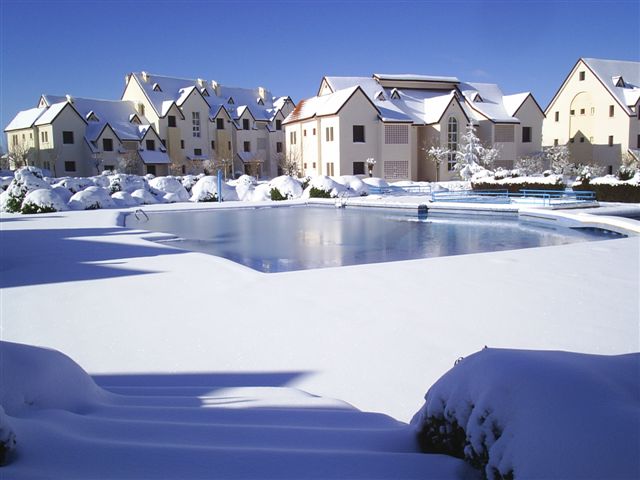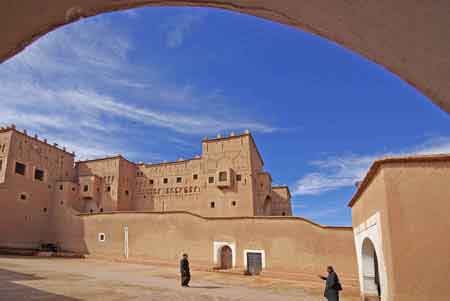The city of Meknes, a UNESCO World Heritage Site, is one of the four imperial cities. The old imperial city houses the mausoleum of Moulay Ismail with magnificent ceilings of painted cedar. The medina has a museum that is also worth visiting, the Dar Jamaï Museum, housed in a splendid house dating from 1882. Meknes, smaller than its neighbor Fez, invites the stroller to stroll along the narrow streets and discover its wonders.
The Almoravids make it a military site in the 11th century. The Almohads destroyed the city, guilty of resistance, to build a larger and more charming one with mosques and powerful fortifications. When they seized it, the Merinids constructed medersas, kasbahs and mosques at the beginning of the 14th century. Under the Wattassids, it was a prosperous city.
In the eighteenth century, Meknes became the administrative capital of Morocco, under the reign of the Alawite Sultan Moulay Ismail, who made the glory of the city thanks to the money derived from the resale of Christian sailors captured on sea and kept in the Huge underground prison "Qara Prison".
Meknes is situated on the plateau which dominates the wadi Boufekrane and the wadi Rdom. It occupies an area of contact between two mountain complexes, the Pre Rif and the western Middle Atlas. The city of Meknes is built on a plateau of an altitude of about 600m. To the east, this plateau is in contact with the Zégotta pass, with the lower valley of Sebou, and from the west it is extended by the Atlantic plateaux and plains. This privileged situation at the confluence of the main thoroughfares of communication has also earned Meknes the name of "hub of Morocco".
Meknes enjoys an essentially Mediterranean climate influenced by the Middle Atlas and the Atlantic Ocean with precipitation ranging from 400 to 500 mm / year. But thunderstorms can be a rare violence.
Meknes benefits from fertile soils ensuring a great richness reinforced by the importance of its hydrography. Indeed, three wadis cross the city: the wadis Bou Ishaq, Ouislane and Boufekrane.
The old part of the city is belted about 40 km by ramparts consisting of three enclosures. The first, low, was intended to stop the riders. The second, higher, prevented the infantry from penetrating into the city. The third, even higher, stopped all those who had succeeded in passing the first two obstacles. This imposing wall built during the reign of Moulay Ismail to defend the entrance to the city was pierced with monumental gates, towers and bastions.
 This door, built in the 17th century by order of the Sultan Moulay Ismail, opens on the northern district of the medina, manufacturers of packs, from which it takes its name. It has two square bastions, decorated with green earthenware. Its triumphal arch frames the minaret of the Berdain mosque built at the same time. The gate of the packs is an example of Alawite construction of the end of the 17th century, inspired by the military architectural tradition of the Saadians. It compensates for its massive appearance by an ornamentation of ceramics with green dominance and a rich decoration of kelp characters in "zelliges".
This door, built in the 17th century by order of the Sultan Moulay Ismail, opens on the northern district of the medina, manufacturers of packs, from which it takes its name. It has two square bastions, decorated with green earthenware. Its triumphal arch frames the minaret of the Berdain mosque built at the same time. The gate of the packs is an example of Alawite construction of the end of the 17th century, inspired by the military architectural tradition of the Saadians. It compensates for its massive appearance by an ornamentation of ceramics with green dominance and a rich decoration of kelp characters in "zelliges".
For art lovers it is a beautiful mix of geometric shapes intertwined with colors, but also it regularly houses exhibitions of Moroccan and international artists.
According to the story of Meknes, Bab Mansour was built by a Christian architect named "the Victorious Renegade" after having converted to Islam he bore the name of Mansour Laalej which earned him his nickname "Bab Mansour".
Walili is the Berber name of the city and originates from the flower of the bindweed. The presence of an oil press testifies to an intense commercial activity based on olive oil. Excavations have shown the occupation of this site since the Neolithic era but its development will not be born the IInd century BC.
The kingdom of Mauretania was occupied by the Romans as early as 42 AD and it was not until after the assassination of Caligula that Volubilis became the capital of the Roman administration in Mauritania.
The occupation of the Romans ceased in 429 with the invasion of the vandals from Spain.
The Islamization of the Maghreb began with the Abassids who settled in 681 in Volubilis. Idriss I settled there in 789 after his flight from Baghdad to escape the Abassids and the defeat of the battle of Fakh. Volubilis became Walila. Idriss II son of Idriss I founded the city of Fes in 818, which caused the decline of Volubilis.
History of Meknes:
The history of Meknes seems to go back to the creation of an unfortified rural village in the eighth century. The establishment in the ninth century of a Berber tribe, the Meknassa, who set up their camp north of Wadi Boufekrane, gave its name to the city.The Almoravids make it a military site in the 11th century. The Almohads destroyed the city, guilty of resistance, to build a larger and more charming one with mosques and powerful fortifications. When they seized it, the Merinids constructed medersas, kasbahs and mosques at the beginning of the 14th century. Under the Wattassids, it was a prosperous city.
In the eighteenth century, Meknes became the administrative capital of Morocco, under the reign of the Alawite Sultan Moulay Ismail, who made the glory of the city thanks to the money derived from the resale of Christian sailors captured on sea and kept in the Huge underground prison "Qara Prison".
Geography and climate of the city of MEKNES :
Map - MeknesMeknes is situated on the plateau which dominates the wadi Boufekrane and the wadi Rdom. It occupies an area of contact between two mountain complexes, the Pre Rif and the western Middle Atlas. The city of Meknes is built on a plateau of an altitude of about 600m. To the east, this plateau is in contact with the Zégotta pass, with the lower valley of Sebou, and from the west it is extended by the Atlantic plateaux and plains. This privileged situation at the confluence of the main thoroughfares of communication has also earned Meknes the name of "hub of Morocco".
Meknes enjoys an essentially Mediterranean climate influenced by the Middle Atlas and the Atlantic Ocean with precipitation ranging from 400 to 500 mm / year. But thunderstorms can be a rare violence.
Meknes benefits from fertile soils ensuring a great richness reinforced by the importance of its hydrography. Indeed, three wadis cross the city: the wadis Bou Ishaq, Ouislane and Boufekrane.
To visit :
 The walls
The walls
The old part of the city is belted about 40 km by ramparts consisting of three enclosures. The first, low, was intended to stop the riders. The second, higher, prevented the infantry from penetrating into the city. The third, even higher, stopped all those who had succeeded in passing the first two obstacles. This imposing wall built during the reign of Moulay Ismail to defend the entrance to the city was pierced with monumental gates, towers and bastions.Bab Berdaine
 This door, built in the 17th century by order of the Sultan Moulay Ismail, opens on the northern district of the medina, manufacturers of packs, from which it takes its name. It has two square bastions, decorated with green earthenware. Its triumphal arch frames the minaret of the Berdain mosque built at the same time. The gate of the packs is an example of Alawite construction of the end of the 17th century, inspired by the military architectural tradition of the Saadians. It compensates for its massive appearance by an ornamentation of ceramics with green dominance and a rich decoration of kelp characters in "zelliges".
This door, built in the 17th century by order of the Sultan Moulay Ismail, opens on the northern district of the medina, manufacturers of packs, from which it takes its name. It has two square bastions, decorated with green earthenware. Its triumphal arch frames the minaret of the Berdain mosque built at the same time. The gate of the packs is an example of Alawite construction of the end of the 17th century, inspired by the military architectural tradition of the Saadians. It compensates for its massive appearance by an ornamentation of ceramics with green dominance and a rich decoration of kelp characters in "zelliges".Bab Mansour Laalej
The Mansour Gate or Bab el-Mansour in Arabic was erected in 1732 under the reign of Moulay Ahmad son of Moulay Ismail. It is considered one of the most beautiful works of Moulay Ismail and ranked one of the most beautiful doors in the world.For art lovers it is a beautiful mix of geometric shapes intertwined with colors, but also it regularly houses exhibitions of Moroccan and international artists.
According to the story of Meknes, Bab Mansour was built by a Christian architect named "the Victorious Renegade" after having converted to Islam he bore the name of Mansour Laalej which earned him his nickname "Bab Mansour".
The souk
The covered souk of Meknes is very nice, and much quieter than that of Marrakech or Fez. You can walk around without being disturbed all the time to have to buy souvenirs, carpets and slippers. In Meknes, the souk covers half a dozen main streets, it is less likely to get lost and a guide is not indispensable, because the city is small and there is always an easily recognizable place nearby. In the souk, one can find everything: shoes, dresses, custom clothes, dry fruits and varieties of souvenirs to take away.Volubilis
It is a Roman city which is located near the holy city of Moulay Idriss Zerhoun where is buried the founder of the Idrissid Idriss 1st dynasty.Walili is the Berber name of the city and originates from the flower of the bindweed. The presence of an oil press testifies to an intense commercial activity based on olive oil. Excavations have shown the occupation of this site since the Neolithic era but its development will not be born the IInd century BC.
The kingdom of Mauretania was occupied by the Romans as early as 42 AD and it was not until after the assassination of Caligula that Volubilis became the capital of the Roman administration in Mauritania.
The occupation of the Romans ceased in 429 with the invasion of the vandals from Spain.
The Islamization of the Maghreb began with the Abassids who settled in 681 in Volubilis. Idriss I settled there in 789 after his flight from Baghdad to escape the Abassids and the defeat of the battle of Fakh. Volubilis became Walila. Idriss II son of Idriss I founded the city of Fes in 818, which caused the decline of Volubilis.
For Hotels and restaurants in Meknes, I recommend those one : Hotels - Restaurants

















































